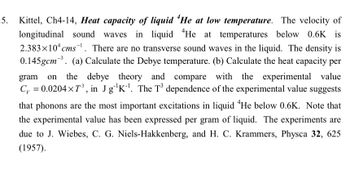Question

Transcribed Image Text:5.
Kittel, Ch4-14, Heat capacity of liquid He at low temperature. The velocity of
longitudinal sound waves in liquid He at temperatures below 0.6K is
2.383×10 cms. There are no transverse sound waves in the liquid. The density is
0.145gcm³. (a) Calculate the Debye temperature. (b) Calculate the heat capacity per
gram on the debye theory and compare with the experimental value
C₁ = 0.0204×7³, in Jg¹K¹. The T³ dependence of the experimental value suggests
that phonons are the most important excitations in liquid He below 0.6K. Note that
the experimental value has been expressed per gram of liquid. The experiments are
due to J. Wiebes, C. G. Niels-Hakkenberg, and H. C. Krammers, Physca 32, 625
(1957).
Expert Solution
This question has been solved!
Explore an expertly crafted, step-by-step solution for a thorough understanding of key concepts.
This is a popular solution
Trending nowThis is a popular solution!
Step by stepSolved in 2 steps with 2 images

Knowledge Booster
Similar questions
- ASK YOUR TEACHE DETAILS OBINPHYS8 6.P.009. ........................ ..... ************ l Verify the values given in the textbook for the wavelengths (in air) of the lowest and highest frequencies of sound that people can hear (20 and 20,000 Hz, respectively). (Round your answers to at least three significant figures in meters and assume air temperature to be 20°C.) lowest-frequency wavelength highest-frequency wavelength Submit Answerarrow_forwardand what techniques are used to observe them. 3. Assuming a sound speed of 1500 m/s; if we send a pulse towards nadir and receive an echo return after 0.5s, what is the depth of the seabed? If we send the same pulse through warmer water and still obtain a return after 0.5s, would you expect the depths to be the same? Explain.arrow_forwardM Inbox (3,462) - sadik1261@gm X P Course Home E MasteringPhysics: HW3 b My Questions | bartleby | New Tab A session.masteringphysics.com/myct/itemView?assignmentProblemlD=134309555 Apps (1) ইমাম মাহদী কবে.. * YouTube to MP3 Co... phone cover for mo... AGARWAL-PHY-166arrow_forwardarrow_back_iosarrow_forward_ios